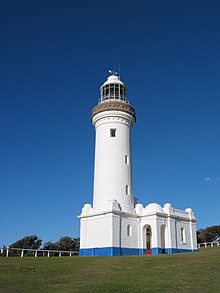 Norah Head Light in 2009 | |
 | |
| Location | Norah Head, New South Wales, Australia |
|---|---|
| Coordinates | 33°16′54″S 151°34′35″E / 33.281669°S 151.576375°E |
| Tower | |
| Constructed | 1903 |
| Construction | concrete block |
| Height | 90 ft (27 m) |
| Shape | cylindrical tower attached to 1-story keeper's house |
| Markings | white |
| Power source | mains electricity |
| Operator | Australian Maritime Safety Authority |
| Light | |
| Focal height | 151 ft (46 m) (white), 128 ft (39 m) (red), 144 ft (44 m) (green) |
| Lens | 1st order bivalve Chance Bros. dioptric Fresnel lens |
| Intensity | 1,000,000 candela |
| Range | 26 nmi (48 km; 30 mi) (white), 7 nmi (13 km; 8.1 mi) (red), 8 nmi (15 km; 9.2 mi) (green) |
| Characteristic | |
Norah Head Light is an active lighthouse located at Norah Head, a headland on the Central Coast, New South Wales, Australia, close to Toukley. It is the last lighthouse of the James Barnet style to be built,[1] and the last staffed lighthouse constructed in New South Wales.[2]
Officially displayed for the first time in 1903, the original vaporized kerosene burner was upgraded in 1923, electrified in 1961 and automated and demanned in 1994, after more than 90 years of being staffed.[2] It celebrated its centenary in 2003.[1]
The concrete block tower is 27.5 metres (90 ft) high, topped by a bluestone gallery. On top of the gallery is the original Chance Bros. lantern. This lantern holds the original housing of the Chance Bros. 1st order bivalve dioptric Fresnel lens. Other important structures include the chief lightkeeper's cottage and assistant keeper's duplex, and a flag house.[3]